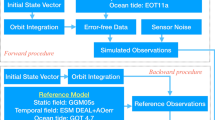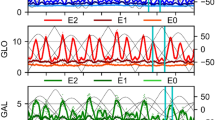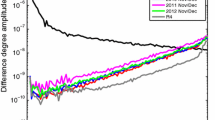Abstract
Many geoscience disciplines push for ever higher requirements on accuracy, homogeneity and time- and space-resolution of the Earth’s gravity field. Apart from better instruments or new observables, alternative satellite formations could improve the signal and error structure compared to Grace. One possibility to increase the sensitivity and isotropy by adding cross-track information is a pair of satellites flying in a pendulum formation. This formation contains two satellites which have different ascending nodes and arguments of latitude, but have the same orbital height and inclination. In this study, the semi-analytical approach for efficient pre-mission error assessment is presented, and the transfer coefficients of range, range-rate and range-acceleration gravitational perturbations are derived analytically for the pendulum formation considering a set of opening angles. The new challenge is the time variations of the opening angle and the range, leading to temporally variable transfer coefficients. This is solved by Fourier expansion of the sine/cosine of the opening angle and the central angle. The transfer coefficients are further applied to assess the error patterns which are caused by different orbital parameters. The simulation results indicate that a significant improvement in accuracy and isotropy is obtained for small and medium initial opening angles of single polar pendulums, compared to Grace. The optimal initial opening angles are \(45^\circ \) and \(15^\circ \) for accuracy and isotropy, respectively. For a Bender configuration, which is constituted by a polar Grace and an inclined pendulum in this paper, the behaviour of results is dependent on the inclination (prograde vs. retrograde) and on the relative baseline orientation (left or right leading). The simulation for a sun-synchronous orbit shows better results for the left leading case.

















Similar content being viewed by others
References
Anselmi A, Visser PNAM, van Dam T, Sneeuw N, Gruber T, Altes B, Christophe B, Cossu F, Ditmar P, Murböck M, Parisch M, Renard M, Reubelt T, Sechi G, Texieira Da Encarnacao JG (2011) Assessment of a next generation gravity mission to monitor the variations of Earth’s gravity field. ESA-contract No.: 22643/09/NL/AF, Executive Summary, Thales Alenia Space report, SD-RP-AI-0721, March 2011
Bender P, Wiese D, Nerem R (2008) A possible dual-GRACE mission with 90 degree and 63 degree inclination orbits. In: 3rd international symposium on formation flying, mission and technology, pp 1–6, Noordwijk, Netherlands. ESA SP-654. ISBN 978-92-9221-218-6
Colombo OL (1984) The global mapping of gravity with two satellites. Publications on Geodesy, vol 7, New Series 3, Netherlands Geodetic Commission
Elsaka B, Raimondo J-C, Brieden P, Reubelt T, Kusche J, Flechtner F, Iran Pour S, Sneeuw N, Müller J (2013) Comparing seven candidate mission configurations for temporal gravity field retrieval through full-scale numerical simulation. J Geodesy 88(1):31–43
Giacaglia GEO (1980) Transformations of spherical harmonics and applications to geodesy and satellite theory. Studia geoph. et geod 24:1–11
Gruber T, NGGM-D Team (2014) e2.motion: Earth system mass transport mission (Square)—concept for a next generation gravity field mission—final report of project satellite gravimetry of the next generation (NGGM-D). Deutsche Geodätische Kommission der Bayerischen Akademie der Wissenschaften, Reihe B Angewandte Geodäsie Heft Nr. 318, München, ISBN 978-3-7696-8597-8
Hill GW (1878) Researches in the lunar theory. American Journal of Mathematics, 1:5–26, 129–147, 245–260. The Johns Hopkins University Press
Iran Pour S, Reubelt T, Sneeuw N (2013) Quality assessment of sub-Nyquist recovery from future gravity satellite missions. Adv Space Res 52(5):916–929
Mackenzie R, Moore P (1997) A geopotential error analysis for a non planar satellite to satellite tracking mission. J Geodesy 71:262–272
Morse PM, Erdelyi A, Gray MC, Metropolis N, Rosser JB, Thacher Jr HC, Todd J, Tompkins CB, Tukey JW (1972) Handbook of mathematical functions with formulas, graphs, and mathematical tables. In: Abramowitz M, Stegun IA (eds) National Bureau of Standards, Applied Mathematics Series 55. United States Department of Commerce, Washington, D.C., USA
NG2 Team (2011) Assessment of a next generation gravity mission to monitor the variations of Earth’s gravity field. Final report, ESTEC Contract No.: 22672/09/NL/AF, Doc. No.: NG2-ASG-FR, Issue:1. 10 Oct 2011
Reubelt T, Sneeuw N, Iran Pour S (2011) Quick-look gravity field analysis of formation scenarios selection. In: Geotechnologien, Science Report No. 17, pp 126–133. Statusseminar “Observation of the System Earth from Space”
Reubelt T, Sneeuw N, Iran Pour S, Hirth M, Fichter W, Müller J, Brieden P, Flechtner F, Raimondo J-C, Kusche J, Elsaka B, Gruber T, Pail R, Murböck M, Doll B, Sand R, Wang X, Klein V, Lezius M, Danzmann K, Heinzel G, Sheard B, Rasel E, Gilowski M, Schubert C, Schäfer W, Rathke A, Dittus H, Pelivan I (2014) Future gravity field satellite missions. In: Flechtner F, Sneeuw N, Schuh W-D (eds) Observation of the system Earth from space—CHAMP, GRACE, GOCE and future missions. Springer, Berlin, pp 165–230
Schaub H, Junkins JL (2002) Analytical mechanics of aerospace systems. AIAA education series, Reston
Schrama EJO (1991) Gravity field error analysis: applications of global positioning system receivers and gradiometers on low orbiting platforms. J Geophys Res 96(B12):20041–20051
Sharifi M, Sneeuw N, Keller W (2007) Gravity recovery capability of four generic satellite formations. In: 1st Int. Symp. of the International Gravity Field Service, vol 18, pp 211–216, Istanbul, Turkey. ISSN 1300-5790
Sneeuw N (1992) Representation coefficients and their use in satellite geodesy. Manuscripta Geodaetica 17:117–123
Sneeuw N (2000) A semi-analytical approach to gravity field analysis from satellite observations. PhD thesis, Technische Universität München
Sneeuw N, Schaub H (2005) Satellite clusters for future gravity field missions. In: Jekeli C, Bastos L, Fernandes J (eds), Gravity, geoid and space missions, vol 129, 2005, pp 12–17, Porto, Portugal. GGSM 2004 IAG International Symposium. ISBN: 978-3-540-26930-4 (Print) 978-3-540-26932-8 (Online)
Tapley BD, Watkins MM, Bettadpur S, Reigber C (2004) The gravity recovery and climate experiment: mission overview and early results. Geophys Res Lett 31:L09607. Provided by the SAO/NASA Astrophysics Data System
Visser PNAM (2005) Low-low satellite-to-satellite tracking: a comparison between analytical linear orbit perturbation theory and numerical integration. J Geodesy 79:160–166
Visser PNAM, van den IJssel J, Koop R, Klees R (2001) Exploring gravity field determination from orbit perturbations of the european gravity mission GOCE. J Geodesy 75:89–98
Wiese DN, Folkner WM, Nerem RS (2009) Alternative mission architectures for a gravity recovery satellite mission. J Geodesy 83(6):569–581
Acknowledgments
We are grateful to the four anonymous reviewers and the editor whose comments and suggestions have significantly improved the manuscript. We like to thank Prof. Min Zhong, Prof. Zebing Zhou and Prof. Hou-Tse Hsu for their helpful suggestions. This work was started during the stay of the first author in GIS, thanks to the scholarship provided by the China Scholarship Council. This work was supported by the State Key Program of National Natural Science Foundation of China (Grants 11235004) and Strategic Leading Science and Technology project, B category (Grants Y604111011).
Author information
Authors and Affiliations
Corresponding author
Appendix: Fourier coefficients
Appendix: Fourier coefficients
The Fourier coefficients of the time-variable opening and central angle can be found numerically (see formula (21)). As an alternative, closed formulas are derived, which enable the determination of the coefficients via complete elliptic integrals based on the distances \(\rho _{x,0}\) and \(\rho _{y,0}\).
The distance between the two satellites is given by \(\rho (t) = \sqrt{\rho _{x}^2+\rho _{y}^2+\rho _z^2}\), where \(\rho _z\) is very small compared to the other components. In the planar approximation (see Sect. 3), the distance simplifies to
and the sine and cosine of the opening angle \(\delta (t)\) become:
where \(\rho _{x,0}\) and \(\rho _{y,0}\) are the maximal distortions.
A close inspection leads to the following conclusions:
-
All components in the second column are even functions, and so the coefficients can be found by cosine transformation:
$$\begin{aligned} f&\approx A_0 + \sum \limits _{p=1}^{\infty } \Big (A_{p} \cos p\dot{u}t+A_{-p}\cos (-p\dot{u}t)\Big ).\\ \Rightarrow&A_{p}=\frac{1}{2}\cdot \frac{2}{T}\int \limits _{0}^{T} f(t) \cos p\dot{u} t \mathrm {d}t\quad \quad \text {with } A_{p} = A_{-p}, \end{aligned}$$and analogous for \(B_{p}\). Compared to standard notation, the coefficients contain the factor \(\frac{1}{2}\), to consider positive and negative indexes.
-
One revolution of the satellites is equal to a period \(T = \frac{2\pi }{\dot{u}}\) for the integration.
-
Due to the \(\cos ^2\)-term in the denominator, the series of \(\cos \delta (t)\) is also symmetric for half of the period; hence, it contains only even indexes \(p = \{0,\pm 2,\pm 4,\ldots \}\).
-
Due to the \(\cos \)-factor in the numerator, the series of \(\sin \delta (t)\) collects only odd indexes \(p = \{\pm 1,\pm 3,\pm 5, \ldots \}\).
The Fourier coefficients are derived by the following steps:
-
1.
consider the symmetries to reduce the period of integration by a factor of 4;
-
2.
replace \(\cos ^2 \dot{u} t\) by \((1-\sin ^2 \dot{u} t);\)
-
3.
express \(\cos (p\dot{u}t)\)-terms in powers of \(\sin {\dot{u}t};\)
-
4.
introduce the variable \(K = \frac{\rho _{y,0}}{\sqrt{\rho _{x,0}^2+\rho _{y,0}^2}}\), which will be later identified with the module of the elliptic integrals;
-
5.
use substitution \(\xi = \sin \dot{u} t\) and \(\mathrm {d}\xi = \dot{u} \cos \dot{u} t \mathrm {d}t\) to achieve the elliptic integrals in the representation of Jacobi:
$$\begin{aligned} \mathcal {F}(\phi ,K)&:= \int \limits _{0}^{\sin \phi } \frac{1}{\sqrt{1-K^2\xi ^2}\sqrt{1-\xi ^2}}\mathrm {d}\xi \end{aligned}$$(30)$$\begin{aligned} \mathcal {E}(\phi ,K)&:= \int \limits _{0}^{\sin \phi } \frac{\sqrt{1-K^2\xi ^2}}{\sqrt{1-\xi ^2}}\mathrm {d}\xi , \end{aligned}$$(31)which leads to the complete elliptic integrals for \(\phi = \frac{\pi }{2}\) (Morse et al. 1972)[pp. 587–626].
The first coefficients of the Fourier series of \(\cos {\delta }(t)\) can be calculated by

The subsequent coefficients are calculated by
To apply the previous steps, in particular the last substitution, it is convenient to express the numerator in polynomials of \(\xi = \sin \dot{u} t\). Based on the identity
of de Moivre and the binomial series (Morse et al. 1972 p. 74, p. 10), we find
With the abbreviation
the Fourier coefficients are calculated by
Coefficients and Fourier synthesis for an initial opening angle of \(\delta _0 = 45^\circ \), inclination of \(I = 90^\circ \) and orbital height of \(h = 335\,\mathrm{km}\). The left column is the Fourier coefficients for time series \(\cos \delta (t)\), \(\sin \delta (t)\) and \(\sin \eta (t)\). The middle column is the reconstructions with different orders for \(\cos \delta (t)\), \(\sin \delta (t)\) and \(\sin \eta (t)\) in one revolution. The right column is the reconstruction errors
The remaining integral can be expressed by a combination of complete elliptic integrals and polynomials. To find a recursion formula, the auxiliary function \(g(\xi ):=\xi ^{2n-1}R(\xi )\) with \(n\ge 1\) is differentiated:
Dividing by \(a_0(K)\) and considering \(\sin \frac{\pi }{2} = 1\) leads to
where the left-hand side is zero for the given limits.
In other words, we find a three-term recursion
with the initial values
and
The coefficients of \(\sin \delta (t)\) are found by the integrals
with \(p = 2s+1,s\in \mathbb {N}\).
Appling again the identities of de Moivre and the binomial series leads to
and the coefficients
where the remaining integral is solved with the same 3-term-recursion (36).
Analogously, the closed formula for the Fourier coefficients for the sine of half of the central angle \(\eta (t)\) can be derived.
From Fig. 4, the relation between the central angle and the inter-satellite distance \(\rho = \sqrt{\rho _x^2+\rho _y^2}\) can be gathered and the relevant projection \(\sin \eta (t)\) can be developed in a Fourier series
The term \(\sin \eta \) is also an even function, such that the coefficients can be found by the cosine transformation and only even indexes remain. Now, the same strategy can be applied to derive the closed forms of the Fourier coefficients

The subsequent coefficients are calculated by
with \(p =2s, s\in \mathbb {N}\).
Applying the means of the previous substitution and the equation (32), we obtain finally
The remaining integrals can again be solved by the three-term recursion (36) in terms of the complete elliptic integrals.
The Fourier coefficients \(A_{2s}\), \(B_{2s+1}\) and \(C_{2s}\), the reconstruction of different truncation levels \(P=2s_{\max }\) (\(P=2s_{\max }+1\)) for the time series \(\cos \delta (t)\), \(\sin \delta (t)\) and \(\sin \eta (t)\) and the reconstruction errors are displayed in Fig. 18 for the pendulum with the initial opening angle \(\delta _0=45^\circ \).
The amounts of elements for the series expansions up to a threshold level of \(1 \%\) are summarized in Table 2. As it can be seen, the convergence of the Fourier series expansion is quite fast, but decreases for larger initial opening angles.
Rights and permissions
About this article
Cite this article
Li, H., Reubelt, T., Antoni, M. et al. Gravity field error analysis for pendulum formations by a semi-analytical approach. J Geod 91, 233–251 (2017). https://doi.org/10.1007/s00190-016-0958-x
Received:
Accepted:
Published:
Issue Date:
DOI: https://doi.org/10.1007/s00190-016-0958-x





